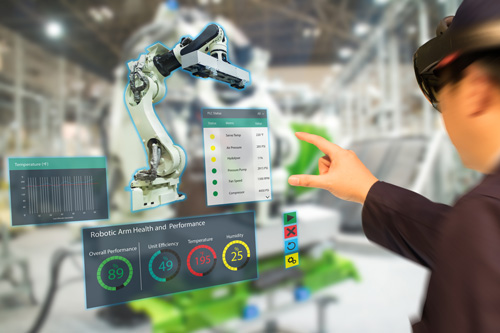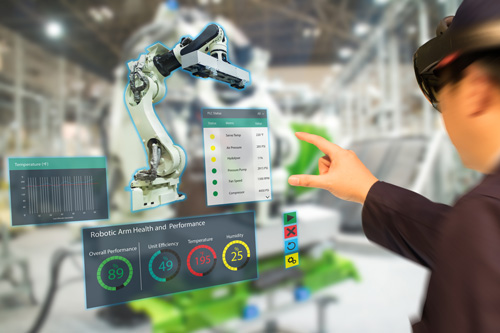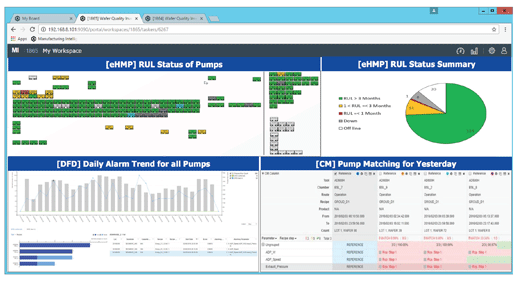- By Stewart Chalmers, James Na
- Automation IT
Summary
Fast Forward
- AI-based equipment health monitoring and prediction systems save time and expense by eliminating equipment failure and downtime.
- With IIoT, the cloud, and big data analytics, AI-based HMP systems help factories to better detect, analyze, and predict solutions to everyday manufacturing problems.
- By using sensors at each step of the production process, adaptive intelligence monitors equipment and outputs in real time.

Smart manufacturing seeks to make equipment downtime a thing of the past

New real-time, equipment health monitoring and prediction (HMP) systems are the first of many exciting AI-based applications that combine embedded human knowledge and advanced engineering automation. They help factories to better detect, analyze, predict, and prescribe solutions to complex, everyday manufacturing problems in real time.
In today's connected world, manufacturers who do not take advantage of the Industrial Internet of Things (IIoT) will soon find themselves left behind. IoT is fueling a wave of new artificial intelligence-based, adaptive intelligence applications for smart manufacturing. They offer the potential for massive reductions in manufacturing costs and eliminating machine downtime. How? Manufacturers are sitting on a wealth of data. Until recently, providing engineers and other stakeholders with access to this data at the right place and at the right time was not possible. Now, however, in the age of IIoT, the cloud, and big data, smart manufacturing is making this goal achievable, so employees in engineering, supply chain, and management can make more informed decisions in real time. To meet the demands of the fast-growing smart manufacturing sector, equipment HMP technology has AI-based applications that combine embedded human knowledge and advanced engineering automation to help factories solve problems.
The equipment health monitoring and predictive technology saves manufacturers time and expense by reducing two of the leading losses for the manufacturing industry: equipment failure and downtime.
Where there's a sensor there's a way
AI-based equipment HMP creates a way to not only take the risk out of manufacturing, but also to reduce risk for all industrial manufacturers, including those in the electronics, energy, automotive, steel, and pharmaceutical sectors. Through the use of sensors for each step of the production process, equipment and outputs are monitored in real time by an adaptive intelligence (AI) that provides a fault detection system, early warning alarms to prevent failure, and remaining useful life (RUL) calculations for all manufacturing equipment. Downtime is drastically cut, because maintenance is only performed as needed and where needed. In addition, of course, the equipment HMP system is highly adaptable to a wide range of industries, enabling smarter manufacturing from the steel and automotive sectors to semiconductors and energy. Manufacturers across all sectors are catching on to this trend. According to a 2017 Gartner Group study, the number of IoT devices installed across the world was 8.4 billion. By 2020, that number will more than double to 20.4 billion IoT devices deployed in the market.
AI-based equipment HMP learns the user's unique configurations and processes to identify anomalies. In steel manufacturing, for example, users are seeing an average lead time reduction of 95 percent and cost reductions of 3 percent. In one study, a top-five global steel maker using a real-time HMP system in a cold-rolling steel mill minimized surface quality issues, such as dents, scratches, and impurities, and solved the root causes of coil contraction. This was accomplished by feeding process data from a plethora of sensors throughout the manufacturing process to an adaptive intelligence. In addition to the process improvements enabled by HMP, accurate predictions of equipment failures avoided costly breakdowns and service disruptions.
Predictability in assembly manufacturing
Equipment HMP has been helpful with overhead hoist transports, ubiquitous in manufacturing spaces of all types. Users often have hundreds of overhead hoist transports on each assembly line, where they are prone to belt cutting, motor speed reductions, and other errors that lead to failure. More importantly, downtime can cause losses of millions of dollars. Monitoring vibration data allows the HMP system to send an alarm one full hour before failure, preventing accidents and saving money. Additionally, equipment HMP enables the user to easily set gold standard hoists for the entire factory floor. That ensures all transports are operating to that standard after any maintenance, and that the user is notified of any deviation from that standard. The RUL of each individual overhead hoist transport can be monitored to maximize maintenance efficiency.
Auto industry and equipment HMP
In addition to the benefits with overhead hoist transports, the HMP technology has enabled auto industry users to dynamically detect faults in real time. In studies with two top auto makers, sensor data was fed directly into the HMP system, where it was collected, analyzed, and compared to both historical data traces and other real-time traces to best identify anomalies. In figure 1, HMP used vibration data to identify faults in a drivetrain and to classify them in real time, saving engineers the trouble and time of diagnosing faults, which can often take weeks or months. When testing the drivetrain or other vital automobile parts, HMP allowed problems to be narrowed down quickly to specific causes, such as broken bearings, misalignment, imbalances, and lack of lubrication.

Golden chamber
The highly automated semiconductor industry has also seen great success with the implementation of HMP systems. In chip manufacturing, there are typically thousands of vacuum pumps on each process line, each producing their own data traces. HMP's adaptive intelligence can monitor all the data simultaneously, in real-time, to detect anomalies and send alarms for faults. Additionally, HMP enables the user to easily set gold standard pumps for chamber matching to ensure that all of the wafers are being produced in the same environment. The RUL of each individual pump can be monitored to maximize maintenance efficiency.
View performance
Users of equipment HMP can customize their dashboards to monitor their equipment, from the entire floor at once down to the individual sensor data on a single machine. In the dashboard image (figure 2), a top semiconductor company implemented the HMP system to monitor its vacuum pumps. The individual RUL of each pump can be viewed on the floor map or as a chart, as seen in the top two windows. The bottom left window shows the alarm trends for all pumps as recorded by the dynamic fault detection system, and the last window shows how select pumps are comparing to the golden pump (top performing reference pump) established by the user.

Foundation for prescriptive, self-healing applications
Equipment HMP takes advantage of full trace data. Unlike most traditional fault detection systems, which compare summary data from equipment to thresholds set by engineers, HMP's fault detection analyzes the full spectrum of data being generated-equipment sensor data and output quality data-and uses it to create dynamically defined control limits.
This means that subtle shifts in equipment functionality and yield quality are identified and investigated. In addition to the data already generated by each piece of equipment, sensors can be placed throughout a manufacturing process, creating a rich mine of information for the adaptive intelligence to learn from and discover patterns in. Remember, smart manufacturing is event driven, meaning that you address issues before they occur and only take machines offline when absolutely necessary.
No more scheduled-based maintenance?
As HMP technology adapts to each unique production environment, it can predict failures and create a smarter alternative to routine maintenance for vital equipment-one based on sensor feedback, big data, and machine learning rather than on-hours and use-time. HMP is the beginning. The next phase for HMP is developing a next-generation, artificial intelligence-based solution that builds a dynamic knowledge base. This will enable machines and systems to detect patterns that they have seen before and prescribe solutions to these problems in real time. For now, though, equipment HMP technology can help bring sizeable improvements in equipment utilization, yield, engineering productivity, and cost reduction to semiconductor, flat panel, display, big pharma, steel, and other manufacturing sectors.
Reader Feedback
We want to hear from you! Please send us your comments and questions about this topic to InTechmagazine@isa.org.


